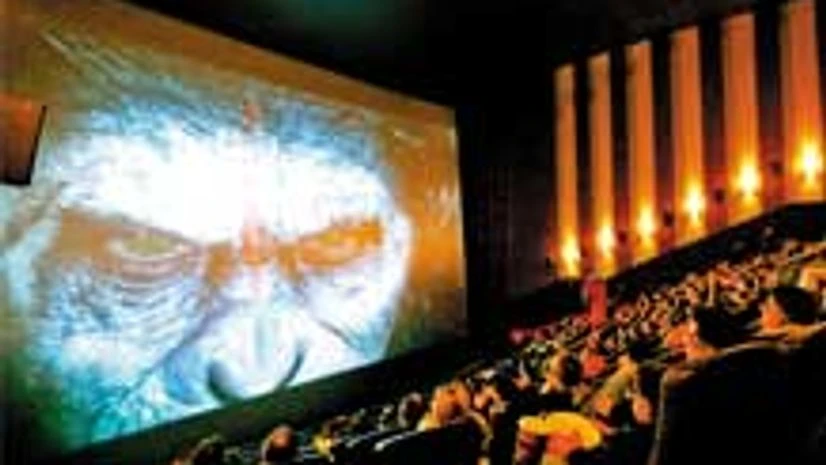On the surface it's just an old-fashioned game of Hollywood tit for tat: Cinemark, the nation's No. 3 theatre chain, has been promoting the growth of its network of extra-large movie screens, and Imax, the standard-bearer in the format for decades, has reacted with popped claws.
"The moviegoing public absolutely loves our premium large-format screens, and studios are noticing the impressive results," says Timothy Warner, Cinemark's chief executive. Richard L Gelfond, Imax's chief executive, says in response: "If you blow up a movie or put it on a larger screen without the proper technology, which is what is happening, you create a blurry, worse image and in a way mislead the customer." Move beyond the saber rattling, however, and a more complicated picture emerges - one that has less to do with a business threat for a still-surging Imax, analysts say, and more with desperation by the big chains to find new ways to grow in the United States and Canada, where attendance has been softening for a decade.
"Cinemark and the other chains realise that U.S. attendance isn't increasing long term, so they need to get more money out of the same person to grow the core business," says Townsend Buckles, a media analyst at J P Morgan Securities. "Adding large-format screens and other premium offerings at an upcharge is one way to do it. It's a smart strategy."
Buckles continues, "But we're not worried for Imax, which has built a brand moviegoers recognise as being the best visual experience. It brings the fan who wants to see a movie in the absolute best format and is willing to drive across town to find it." Imax has steadily expanded beyond its origins as a museum curiosity to become a multiplex fixture in 58 countries. Its theatres, for instance, have become so popular in China that when the Chinese agreed in 2012 to let more Hollywood movies play there, government officials named the Imax format as one that would receive special consideration from censors. Last year, Imax had $727 million in ticket sales, a 17 percent increase from 2012. Large-format theatres, whether Imax or another brand, have been rising in popularity even as the broader moviegoing public sours on 3-D. (About 75 per cent of Imax's releases are in 3-D.) These theatres, analysts note, offer much more than oversize screens. They typically also feature significantly better sound systems and more comfortable chairs.
Cinemark reported $148.5 million in profit last year, a 12 per cent decline from the year earlier. Its shares closed on Friday at $27.73, down about 5 per cent from a year ago. Imax had $44.1 million in profit last year, a 7 per cent increase. Its shares closed on Friday at $27.40, down about 1 percent from a year ago.As much as Imax would like to have the extra-big-screen market to itself, "there is room for both," says Phil Contrino, chief analyst ofBoxOffice.com.
Cinemark Holdings and the country's two biggest theatre chains,Regal Entertainment and AMC Entertainment, together operate hundreds of Imax auditoriums, which use proprietary technology to project movies in extra-high resolution on floor-to-ceiling screens. Ticket buyers pay an extra $3 to $5 to watch movies in them. Imax collects fees from its chain partners totaling about 20 percent of ticket sales.
Five years ago, the chains - led by Cinemark - started using off-the-shelf digital technology to build their own large-format theatres, which they operate under a grab bag of brands, including BigD, ETX, Prime, RPX, UltraAVX and XD. Just as with Imax, moviegoers pay a premium to watch movies in these auditoriums. Unlike with Imax, the chains do not have to share revenue with another exhibitor.
There are now 365 nonmuseum Imax venues in the US. Together the chains operate 325 of their own large-format screens. Recognizing that the mishmash of formats - ETX, RPX, XD and so on - confuses consumers, Cinemark has started referring to the new group of large-format theatres as PLF, or premium large format, which may or may not help.
"We're much more focused on growing our own brand," Williams of Cinemark says, adding that "our technology is every bit as good." Cinemark is also building large-format theatres overseas, with a particular focus in Latin America.
Studios believe that the Imax stamp on a film's marketing materials elevates a film's overall standing, but Imax accepts only a handful of the biggest films each year and plays them exclusively for roughly two weeks, leaving studios without Imax slots. A second large-format network could help solve that problem.
Imax, as demonstrated by its hyperaggressive response to the mere notion of a rival, has a lot on the line. It worries about consumer confusion. The company has also been sparring with a competing large-screen system in China that, Imax has charged in several courts, relies on technology stolen from its Canadian offices. The last thing Imax wants is the appearance that it is now under fire on two fronts.
But analysts say that for the most part, Imax has nothing to worry about in the United States until at least 2021, when large clusters of its leases begin to expire and theatre chains must decide whether to renew or convert to their own label, as Cinemark recently did at one location in Los Angeles.
Studio executives note that Imax also enjoys a strong relationship with marquee directors like Michael Bay, Brad Bird and Christopher Nolan, who have come to insist that their films be released in the format. (Put another way, Imax releases are now how directors determine if they are in Hollywood's big-boy club.)
"I view all the others as just really big screens," says one studio president, speaking on the condition of anonymity because he did not want to be dragged into the public ruckus. "Great. Super. We'll take that money. But Imax is still Imax."
@New York Times

)
